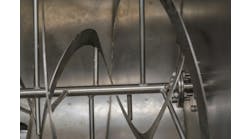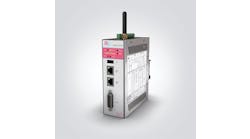Mike Kerscher is technical/application specialist at Mazak.
What have been the biggest improvements to machine-controls technology in the past five years?
Mike Kerscher, technical/application specialist, Mazak: Processing—it continues to get faster and more robust. We no longer worry so much about look-ahead and block-speed capabilities, and machines are no longer constrained by controls. Processors used in machine controls are much higher in quality and performance as compared to those from even five years ago. We’re actually at the point now where multiple processors are used in machine tool controls.
Also read: Think like a machinist
technical/application specialist at Mazak
Simulation and graphics—The integration or connecting of CAD/CAM software to a machine tool can increase the confidence factor when it comes to machining your complex medical parts. When these systems are paired together shops not only gain valuable real-time data at the machine but also the ability to generate more accurate part-program simulations, which in turn increase the odds tremendously of producing a good first part, thus minimizing prove-out time.
When shops run a Mazak simulation, for instance, they get tremendous confidence because it uses all the machine’s data as provided by Mazak the OEM to run the simulation. So what happens is the simulation will happen exactly the same way on the machine as long as the tool data is accurate.
Mazak provides an application programming interface (API) that allows CAM software to seamlessly access data from its machine controls. The CAM software then uses that data to generate extremely accurate part-program simulations. Such an accomplishment was never possible until the development of more robust interfaces.
The development of advanced control functions lets the operator alter cutting paths to create a desired part surface finish or shape or level of machining accuracy. A machine program drives the machine to a certain axis position, and our Smooth Machining Configuration (SMC) determines how it moves to that desired position—for instance, how the machine will decelerate into a curve and accelerate out of it. In essence, the function allows for fine tuning to optimize cutting paths for shorter machining cycle times and improved part surface quality. Prior to such a function, to achieve this same type of result, shops would have to servo tune the machine and its responsiveness. The SMC function is not servo tuning.
What’s the most innovative or efficient machine-controls technology application you’ve ever seen or been involved with?
Mike Kerscher, technical/application specialist, Mazak: Closed-loop machining applications are by far the most innovative and efficient, and, where parts are measured, the control understands the measurements and then determines the appropriate machine programs needed to cut the part to the desired shape and tolerance based on the original condition. There are both
physical examples of these closed-loop processes, as well as virtual ones. A virtual example would be where a part model is created in a CAD system, and the CAD system gathers machine-specific data via an API link, and then the CAD system appropriately modifies the part program to create a desired shape with code specific to that CAD model’s specifications in terms of specific machine settings and tool data.
In one example, Mazak worked with gear production software developer Dontyne Systems and successfully created a closed-loop gear machining process/strategy for easily measuring and validating the accuracy of virtually any machined gear-tooth profile. Through this ground-breaking process, shops with full five-axis multi-tasking capabilities can productively and profitably produce tight-tolerance gears in small and medium volumes. This technique also makes it possible to generate more complex and specialty forms that offer better overall gear performance.
For another application, Mazak developed a closed-loop system that allows the customer to load a used heavy-equipment component on to a machine tool, scan/measure it and determine if it is re-manufacturable and/or reconditioned. If it is, the system automatically determines how much material needs to be removed, creates a program and the machine cuts off the exact amount.
How has machine-controls technology benefitted from remote monitoring and connectivity?
Mike Kerscher, technical/application specialist, Mazak: It has benefitted in terms of off-line programming and simulation capabilities and in standard Ethernet connections that provide seamless interfacing to automation, programming, simulation, machine diagnostics and predictive maintenance. Shops can now, for example, sync their machines with a mobile device to monitor and manage status at any time from a smartphone, tablet or laptop computer.
MTConnect, an open-source, royalty-free manufacturing protocol, lets shops now easily connect devices and systems from different suppliers to safely capture and share information in a common format, such as XML. This connectivity then allows for monitoring and data gathering for process optimization.
For shops to save both time and money, remote service assist-type software enables a machine-tool OEM’s service technicians to troubleshoot a customer's machine tool using standard mobile devices. Augmented reality powers a shared view of the customer's equipment for service assistance and replacement-part identification. Such capability shortens the mean time to repair and often reduces costs associated with in-person field-service calls.
Rather than wait for a customer to send photos of an error message so a technician can guide an inexperienced operator through a procedure, remote service-assist type software enables technicians to provide visual confirmation of each step toward the solution. Additionally, when machines need parts, customers can use the capability to identify the correct replacement so the OEM can ship it to a field-service technician for direct installation. This process eliminates an in-person diagnostics visit before the parts order, avoiding days’ worth of downtime.
Can you explain how software development has changed machine controls in discrete manufacturing?
Mike Kerscher, technical/application specialist, Mazak: Because most of today’s controls have a PC side, custom solutions are possible via executable (.exe) files within the PC of the control. This allows for the creation of essentially macro programs that simplify programs that would otherwise be extremely complex to generate. Users simply fill in basic information, and a cut path is automatically created.
The other result of software is improved machine/control intelligence and the ability to react to conditions and/or surroundings. All the devices on a factory floor are smart enough to react to multiple variable conditions. Machines are basically able to “decide” their next action based on certain conditions. For instance, a machine is connected to a bar feeder, and the bar feeder relays the information to the machine that there is only 6 inches left on a bar of material. The machine/control then “looks” through its schedule and determines if that amount of stock is enough to produce any other parts. If that’s the case, the control will initiate that part to run.
How do control technologies figure into digital-twin platform models being used by manufacturers?
Mike Kerscher, technical/application specialist, Mazak: A digital twin of the machine fills in the missing link between the CNC and the CAM system. With real-time bidirectional access to the machine itself, artificial intelligence within a machine’s CNC can use actual machine parameters, along with fixture, tool and workpiece data, to create a digital replica that shows the actual behavior of equipment during a process and at a specific point in time—real-time traceability.
In essence, digital twin is the collection of data of the machine cutting, as well as the environment in which the cutting took place—material source, wear on cutting tools, coolant concentration, ambient temperature, operator, time of day. With all of this data, big-data-style analysis can be run to analyze potential failures and maintain a history if parts fail in the future, all of which helps improve manufacturing in the long run.
Digital-twin technology is already being used to diagnose, streamline production lines and remove the what-if factor from a wide variety of industrial processes. It also provides a digital record or time stamp within a manufacturing process.
For the first time, next-generation CNCs such as Mazak’s Mazatrol SmoothAi together with digital-twins capability combine the accuracy of digital recreations with the ease of CAM programming to launch a new era of productivity on machine tools.
When will machine controls become IT-friendly enough that engineers are no longer required for installation and operation?
Mike Kerscher, technical/application specialist, Mazak: It’s really not that difficult to install and connect today’s machine tools—basically plug into an Ethernet. On the operation side, we’re not at the plug-and-play level, which is years away, as there are no generic solutions for tooling, workholding and process sequence.
What future innovations will impact the use of machine-controls technology in discrete-manufacturing operations?
Mike Kerscher, technical/application specialist, Mazak: Progression toward the accomplishment of perfect art-to-part processing—advanced CNCs are already providing a strong step toward perfect art-to-part. In other words, the controls make it really easy to program a part.
Another future innovation will be controls that provide secure operation on the Internet.
Tell us about your company’s state-of-the-art machine-controls technology for discrete manufacturing.
Mike Kerscher, technical/application specialist, Mazak: Mazak has set a precedent in CNC development with the introduction of its Mazatrol programming language in 1981. And, over the past three decades, the company has continued to improve upon this programming language to easily put infinite part-production capabilities under a shop’s control.
Mazatrol makes it possible to run Mazak machines using conversational or EIA/ISO programming. Available on all Mazak CNC systems, this proprietary programming language brings versatility and ease of use to the production floor. Within Mazak’s family of Mazatrol Smooth controls are the SmoothEz, SmoothAi, SmoothG, SmoothX and SmoothC, two of which include imbedded PCs and extremely advanced functionality.






